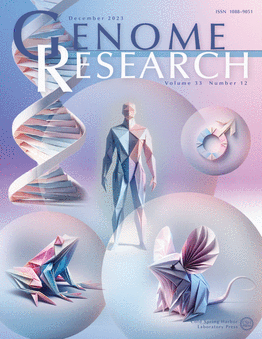Cohesin organizes 3D DNA contacts surrounding active enhancers in C. elegans
IF 6.2
2区 生物学
Q1 BIOCHEMISTRY & MOLECULAR BIOLOGY
引用次数: 0
Abstract
In mammals, cohesin and CTCF organize the 3D genome into topologically associating domains (TADs) to regulate communication between cis-regulatory elements. Many organisms, including S. cerevisiae, C. elegans, and A. thaliana contain cohesin but lack CTCF. Here, we used C. elegans to investigate the function of cohesin in 3D genome organization in the absence of CTCF. Using Hi-C data, we observe cohesin-dependent features called “fountains,” which have also been reported in zebrafish and mice. These are population average reflections of DNA loops originating from distinct genomic regions and are ∼20–40 kb in C. elegans. Hi-C analysis upon cohesin and WAPL-1 depletion supports the idea that cohesin is preferentially loaded at sites bound by the C. elegans ortholog of NIPBL and loop extrudes in an effectively two-sided manner. ChIP-seq analyses show that cohesin translocation along the fountain trajectory depends on a fully intact complex and is extended upon WAPL-1 depletion. Hi-C contact patterns at individual fountains suggest that cohesin processivity is unequal on each side, possibly owing to collision with cohesin loaded from surrounding sites. The putative cohesin loading sites are closest to active enhancers, and fountain strength is associated with transcription. Compared with mammals, the average processivity of C. elegans cohesin is about 10-fold shorter, and the binding of NIPBL ortholog does not depend on cohesin. We propose that preferential loading and loop extrusion by cohesin is an evolutionarily conserved mechanism that regulates the 3D interactions of enhancers in animal genomes.凝聚素组织优雅子中活性增强子周围的三维 DNA 接触
在哺乳动物中,内聚蛋白和CTCF将三维基因组组织成拓扑相关结构域(TADs),以调节顺式调控元件之间的通信。许多生物,包括葡萄球菌、秀丽隐杆线虫和拟南芽胞杆菌都含有内聚蛋白,但缺乏CTCF。在此,我们以秀丽隐杆线虫为研究对象,研究了在缺乏CTCF的情况下,内聚蛋白在三维基因组组织中的功能。使用Hi-C数据,我们观察到称为“喷泉”的黏结蛋白依赖特征,这在斑马鱼和小鼠中也有报道。这些是来自不同基因组区域的DNA环的群体平均反射,在秀丽隐杆线虫中约为20-40 kb。对内聚蛋白和WAPL-1缺失的Hi-C分析支持了这样一种观点,即内聚蛋白优先装载在线虫同源物NIPBL和环挤出物结合的位点上,有效地双向加载。ChIP-seq分析表明,黏结蛋白沿喷泉轨迹的移位依赖于一个完整的复合体,并在WAPL-1耗尽时扩展。单个喷泉的高- c接触模式表明,每一侧的黏结性是不相等的,可能是由于与周围站点加载的黏结物发生碰撞。推测的内聚蛋白装载位点与活性增强子最接近,并且喷泉强度与转录有关。与哺乳动物相比,秀丽隐杆线虫黏附蛋白的平均表达能力短约10倍,并且与NIPBL同源物的结合不依赖于黏附蛋白。我们认为黏结蛋白的优先加载和环挤压是一种进化保守的机制,它调节了动物基因组中增强子的三维相互作用。
本文章由计算机程序翻译,如有差异,请以英文原文为准。
求助全文
约1分钟内获得全文
求助全文
来源期刊

Genome research
生物-生化与分子生物学
CiteScore
12.40
自引率
1.40%
发文量
140
审稿时长
6 months
期刊介绍:
Launched in 1995, Genome Research is an international, continuously published, peer-reviewed journal that focuses on research that provides novel insights into the genome biology of all organisms, including advances in genomic medicine.
Among the topics considered by the journal are genome structure and function, comparative genomics, molecular evolution, genome-scale quantitative and population genetics, proteomics, epigenomics, and systems biology. The journal also features exciting gene discoveries and reports of cutting-edge computational biology and high-throughput methodologies.
New data in these areas are published as research papers, or methods and resource reports that provide novel information on technologies or tools that will be of interest to a broad readership. Complete data sets are presented electronically on the journal''s web site where appropriate. The journal also provides Reviews, Perspectives, and Insight/Outlook articles, which present commentary on the latest advances published both here and elsewhere, placing such progress in its broader biological context.
 求助内容:
求助内容: 应助结果提醒方式:
应助结果提醒方式:


